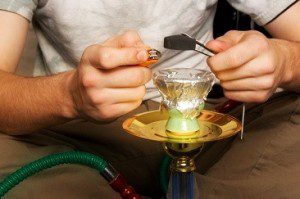 Hookah smoking is growing increasingly popular among teens and young adults, but there are many questions still unanswered about its safety, according to an expert who is studying the issue.
Hookah smoking is growing increasingly popular among teens and young adults, but there are many questions still unanswered about its safety, according to an expert who is studying the issue.
These questions include long-term effects of hookah smoking, the potential health effects for the many users who only smoke hookah a couple of times a month, and whether hookah users are more likely to switch to cigarettes, according to Scott E. Sherman, MD, MPH, Associate Professor in the Department of Population Health at the NYU Langone School of Medicine. He talked about hookah smoking as part of the CASAColumbia Addiction Speaker Series, featuring leading experts in the addiction and substance abuse field.
“If hookah smoking leads to regular smoking then we have a really serious problem on our hands,” he said. Dr. Sherman plans to study that question in a long-term study of students at the City University of New York. “Some data suggests they do escalate and smoke other products,” he said.
Hookah bars feature water pipes that are used to smoke a blend of tobacco, molasses and fruit called shisha. Dr. Sherman says many young people who use hookah mistakenly think the water in the pipe filters all the harmful chemicals in tobacco smoke.
Hookah use roughly doubled among middle and high school students in the United States from 2013 to 2014, according to the Centers for Disease Control and Prevention (CDC). Among high school students, current hookah use rose from 5.2 percent in 2013 (about 770,000 students) to 9.4 percent in 2014 (about 1.3 million students). Among middle school students, current hookah use rose from 1.1 percent in 2013 (120,000 students) to 2.5 percent in 2014 (280,000 students).
Hookah smoking is particularly popular among college students, Dr. Sherman notes. In a survey of New York college students, he found they were most likely to smoke a water pipe at a hookah bar, although some also used a water pipe at home.
He says some students under age 21 say they like to go to hookah bars because they are more likely to be served alcohol there even though they are underage, compared with regular bars. “Students say hookah bars are unlikely to card you,” he said. The fruit-flavored tobacco used in water pipes is also a draw for young people. Water pipe tobacco comes in different flavors, such as apple, mint, cherry, chocolate, coconut, licorice, cappuccino and watermelon.
College students say they enjoy the social aspect of spending several hours in a hookah bar, relaxing with friends.
Studies have found hookah smoke contains dangerous ingredients such as arsenic, lead, nicotine, tar and carbon monoxide. Hookah smoke contains more nicotine and carbon monoxide than regular cigarettes, Dr. Sherman said. “Data suggests there is probably an increased risk of cancer from regular hookah smoking, and increased cardiovascular risk, as well as a risk from toxicants such as carbon monoxide,” he said. According to the CDC, hookah smokers may be at risk for some of the same diseases as cigarette smokers, including oral cancer, lung cancer, stomach cancer and cancer of the esophagus.
Research on the indoor air effects of hookah smoke suggests levels of carbon monoxide increase even in the room next door to where people are smoking hookah, Dr. Sherman said. “This could be a problem in homes with children,” he noted.
One of the reasons it is difficult to determine the health effects of hookah smoking on the average user is that many young people only go to a hookah bar once or twice a month. “Hookah smoking could just be a fad that people do once a month in college, and then they move on and grow up,” he says. “Exposure from hookah smoking once a month for a few years is probably nothing, but if it leads people to smoke more or to smoke other products, then it is a very big deal.”
Published
January 2016
 Get Support
Get Support
